非谓语动词作宾补的比较(百度)
非谓语动词作宾补
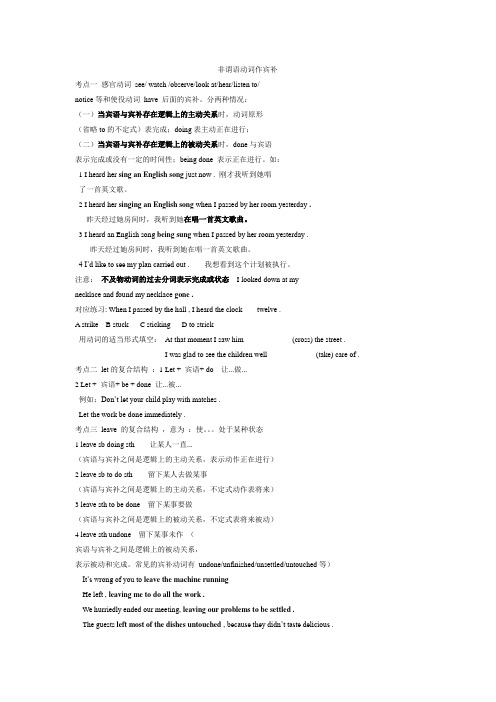
非谓语动词作宾补考点一感官动词see/ watch /observe/look at/hear/listen to/notice等和使役动词have 后面的宾补。
分两种情况:(一)当宾语与宾补存在逻辑上的主动关系时,动词原形(省略to的不定式)表完成;doing表主动正在进行;(二)当宾语与宾补存在逻辑上的被动关系时,done与宾语表示完成或没有一定的时间性;being done 表示正在进行。
如:1 I heard her sing an English song just now . 刚才我听到她唱了一首英文歌。
2 I heard her singing an English song when I passed by her room yesterday .昨天经过她房间时,我听到她在唱一首英文歌曲。
3 I heard an English song being sung when I passed by her room yesterday .昨天经过她房间时,我听到她在唱一首英文歌曲。
4 I’d like to see my plan carried out . 我想看到这个计划被执行。
注意:不及物动词的过去分词表示完成或状态I looked down at mynecklace and found my necklace gone .对应练习: When I passed by the hall , I heard the clock ___ twelve .A strikeB stuckC stickingD to strick用动词的适当形式填空:At that moment I saw him ____________ (cross) the street .I was glad to see the children well ____________ (take) care of . 考点二let的复合结构:1 Let + 宾语+ do 让...做...2 Let + 宾语+ be + done 让...被...例如:Don’t let your child p lay with matches .Let the work be done immediately .考点三leave 的复合结构,意为:使。
非谓语动词作宾补考点解析
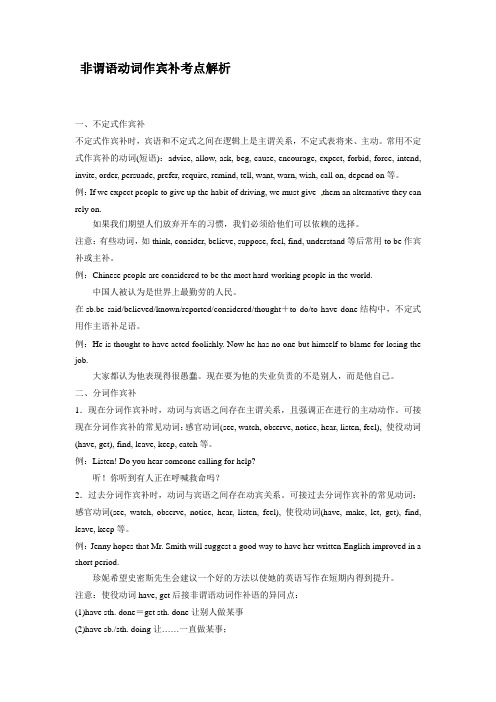
非谓语动词作宾补考点解析一、不定式作宾补不定式作宾补时,宾语和不定式之间在逻辑上是主谓关系,不定式表将来、主动。
常用不定式作宾补的动词(短语):advise, allow, ask, beg, cause, encourage, expect, forbid, force, intend, invite, order, persuade, prefer, require, remind, tell, want, warn, wish, call on, depend on等。
例:If we expect people to give up the habit of driving, we must give them an alternative they can rely on.如果我们期望人们放弃开车的习惯,我们必须给他们可以依赖的选择。
注意:有些动词,如think, consider, believe, suppose, feel, find, understand等后常用to be作宾补或主补。
例:Chinese people are considered to be the most hard-working people in the world.中国人被认为是世界上最勤劳的人民。
在sb.be said/believed/known/reported/considered/thought+to do/to have done结构中,不定式用作主语补足语。
例:He is thought to have acted foolishly. Now he has no one but himself to blame for losing the job.大家都认为他表现得很愚蠢。
现在要为他的失业负责的不是别人,而是他自己。
二、分词作宾补1.现在分词作宾补时,动词与宾语之间存在主谓关系,且强调正在进行的主动动作。
非谓语动词作宾语补足语讲解与练习(修订版)(可编辑修改word版)

非谓语动词作宾语补足语定义:宾语补足语通常是位于宾语之后,说明宾语的状态、特征的成分,多由名词,形容词、副词、不定式,动名词个分词充当.如:The sun keeps us warm.We call her Jenny.They found him out.Make yourself at home.They wish you to go with them.I heard him singing.You must get your hair cut.宾语+宾语补足语=复合宾语,宾语和宾语补足语之间在逻辑上往往有主表、或者主谓的关系.一、动词不定式作宾补。
1.V1 + sb. + to do sth.常用动词有:advise 建议allow 允许ask 叫,请bear 忍受beg 乞求cause 导致command 命令encourage 鼓励expect 期待forbid 禁止force 迫使get 使hate 讨厌help 帮助intend 想要invite 邀请leave 让like 喜欢mean 打算need 需要oblige 迫使order 命令permit 允许persuade 说服prefer 宁愿request 请求remind 提醒teach 教tell 告诉trouble 麻烦want 想要warn 警告wish 希望wait for 等would like 想要would love 想要would prefer 宁愿persuade (劝说)sb to do sth = persuade sb into doing sth温馨提示:1.advise, forbid,allow, permit 这四个词后既可以直接加动名词作宾语,也可以接不定式作宾语补足语,即构成doing sthadvise/ forbid/ allow/ permitsb to do sth2.fear, excuse, refuse, insist, hope, suggest, agree, decide, demand, thank, arrange 等动词后不可接sb to do sth。
非谓语动词做宾语
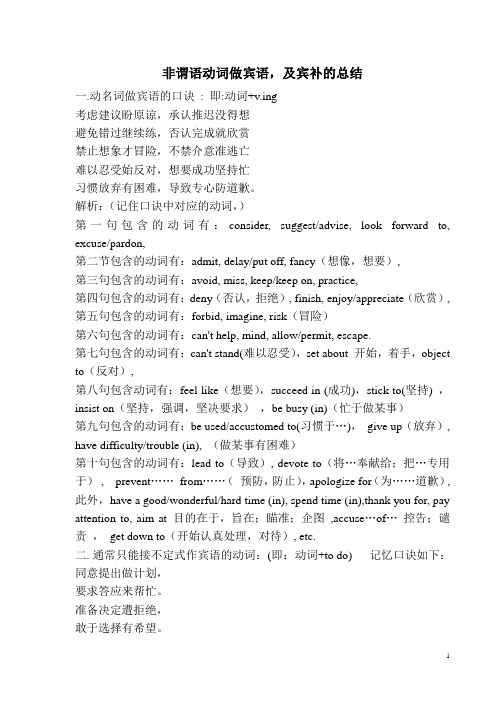
非谓语动词做宾语,及宾补的总结一.动名词做宾语的口诀: 即:动词+v.ing考虑建议盼原谅,承认推迟没得想避免错过继续练,否认完成就欣赏禁止想象才冒险,不禁介意准逃亡难以忍受始反对,想要成功坚持忙习惯放弃有困难,导致专心防道歉。
解析:(记住口诀中对应的动词,)第一句包含的动词有:consider, suggest/advise, look forward to, excuse/pardon,第二节包含的动词有:admit, delay/put off, fancy(想像,想要),第三句包含的动词有:avoid, miss, keep/keep on, practice,第四句包含的动词有:deny(否认,拒绝), finish, enjoy/appreciate(欣赏), 第五句包含的动词有:forbid, imagine, risk(冒险)第六句包含的动词有:can't help, mind, allow/permit, escape.第七句包含的动词有:can't stand(难以忍受),set about 开始,着手,object to(反对),第八句包含动词有:feel like(想要),succeed in (成功),stick to(坚持) ,insist on(坚持,强调,坚决要求),be busy (in)(忙于做某事)第九句包含的动词有:be used/accustomed to(习惯于…),give up(放弃), have difficulty/trouble (in), (做某事有困难)第十句包含的动词有:lead to(导致), devote to(将…奉献给;把…专用于), prevent……from……(预防,防止),apologize for(为……道歉), 此外,have a good/wonderful/hard time (in), spend time (in),thank you for, pay attention to, aim at 目的在于,旨在;瞄准;企图,accuse…of…控告;谴责,get down to(开始认真处理,对待), etc.二. 通常只能接不定式作宾语的动词:(即:动词+to do) 记忆口诀如下:同意提出做计划,要求答应来帮忙。
非谓语动词用法对比

非谓语动词用法对比英语中动词分为两大类:一类是谓语动词,一类是非谓语动词.顾名思义,谓语动词就是在句子中做谓语的动词,即do;而非谓语动词在句子中可以做除了谓语以外的其他任何成分,即doing\to do\done.在句子中充当除谓语以外的各种句子成分的动词形式叫做非谓语动词.非谓语动词有三种:不定式、动名词和分词(现在分词和过去分词).知识要点:一、不定式与动名词做主语:1) 不定式一般表示具体的、特定的行为;而-ing分词一般表示抽象的、一般的行为。
动名词作主语时,它已经将动词名词化了,已把某个动作视为某种活动或事情了,动作意义很弱,比较抽象;而不定式作主语,动作意义强,多指“要去做某事”,这种动作往往是“要发生的一次性动作”,比较具体。
如:To complete the program needs much effort. 完成这项计划需要很大的努力。
Riding a bike can make a man smart. 骑单车能使一个人敏捷。
Smoking is forbiden. 抽烟是禁止的。
To smoke here is not very good. 在这抽烟不太好。
(2) 在疑问句中,只能用动名词的复合结构作主语。
如:Is his speaking reasonable? 她的说话有道理吗?(3) 在某些句型中通常要用动名词短语作主语。
如:It is no use doing…It is no good doing…It is useless doing…It is worthwhile doing…如:It is no use talking your trouble to a man like him. 跟他那样的人谈你的烦恼没有用。
常用不定式做主语的句型有:It’s difficult (important, necessary…) for sb. to do…It’s kind (good, friendly, polite, careless, rude, cruel, clever, foolish, brave…) of sb.to do…(4) 一般说来,作主语和表语的非谓语动词形式应一致,即:或同时为不定式,或同时为-ing 分词。
非谓语动词作宾语补足语的用法及区别-六级语法
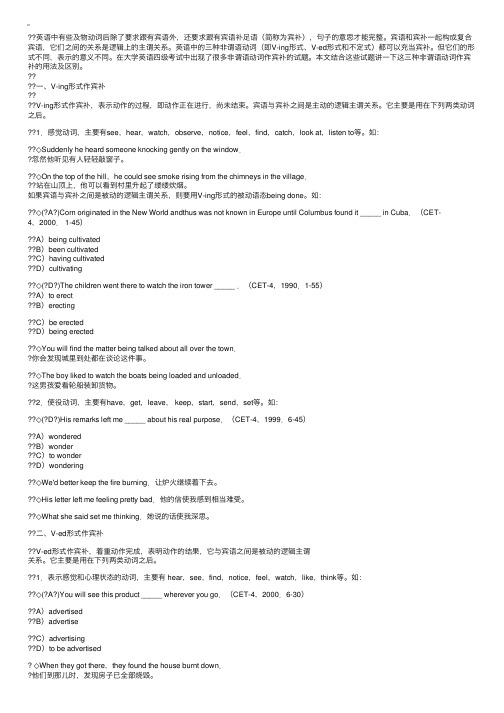
英语中有些及物动词后除了要求跟有宾语外,还要求跟有宾语补⾜语(简称为宾补),句⼦的意思才能完整。
宾语和宾补⼀起构成复合宾语,它们之间的关系是逻辑上的主谓关系。
英语中的三种⾮谓语动词(即V-ing形式、V-ed形式和不定式)都可以充当宾补。
但它们的形式不同,表⽰的意义不同。
在⼤学英语四级考试中出现了很多⾮谓语动词作宾补的试题。
本⽂结合这些试题讲⼀下这三种⾮谓语动词作宾补的⽤法及区别。
⼀、V-ing形式作宾补V-ing形式作宾补,表⽰动作的过程,即动作正在进⾏,尚未结束。
宾语与宾补之间是主动的逻辑主谓关系。
它主要是⽤在下列两类动词之后。
1.感觉动词,主要有see,hear,watch,observe,notice,feel,find,catch,look at,listen to等。
如:◇Suddenly he heard someone knocking gently on the window.忽然他听见有⼈轻轻敲窗⼦。
◇On the top of the hill,he could see smoke rising from the chimneys in the village.站在⼭顶上,他可以看到村⾥升起了缕缕炊烟。
如果宾语与宾补之间是被动的逻辑主谓关系,则要⽤V-ing形式的被动语态being done。
如:◇(?A?)Corn originated in the New World andthus was not known in Europe until Columbus found it _____ in Cuba.(CET-4,2000. 1-45)A)being cultivatedB)been cultivatedC)having cultivatedD)cultivating◇(?D?)The children went there to watch the iron tower _____ .(CET-4,1990.1-55)A)to erectB)erectingC)be erectedD)being erected◇You will find the matter being talked about all over the town.你会发现城⾥到处都在谈论这件事。
(完整版)非谓语动词作宾语补足语讲解与练习(修订版)

非谓语动词作宾语补足语定义:宾语补足语通常是位于宾语之后,说明宾语的状态、特征的成分,多由名词,形容词、副词、不定式,动名词个分词充当.如:The sun keeps us warm.We call her Jenny.They found him out.Make yourself at home.They wish you to go with them.I heard him singing.You must get your hair cut.宾语+宾语补足语=复合宾语,宾语和宾语补足语之间在逻辑上往往有主表、或者主谓的关系.一、动词不定式作宾补。
1.V1 + sb. + to do sth.常用动词有:advise 建议allow 允许ask 叫,请bear 忍受beg 乞求cause 导致command 命令encourage 鼓励expect 期待forbid 禁止force 迫使get 使hate 讨厌help 帮助intend 想要invite 邀请leave 让like 喜欢mean 打算need 需要oblige 迫使order 命令permit 允许persuade 说服prefer 宁愿request 请求remind 提醒teach 教tell 告诉trouble 麻烦want 想要warn 警告wish 希望wait for 等would like 想要would love 想要would prefer 宁愿persuade (劝说)sb to do sth = persuade sb into doing sth温馨提示:1.advise, forbid,allow, permit 这四个词后既可以直接加动名词作宾语,也可以接不定式作宾语补足语,即构成doing sthadvise/ forbid/ allow/ permitsb to do sth2.fear, excuse, refuse, insist, hope, suggest, agree, decide, demand, thank, arrange 等动词后不可接sb to do sth。
非谓语动词做宾语补足语的区别
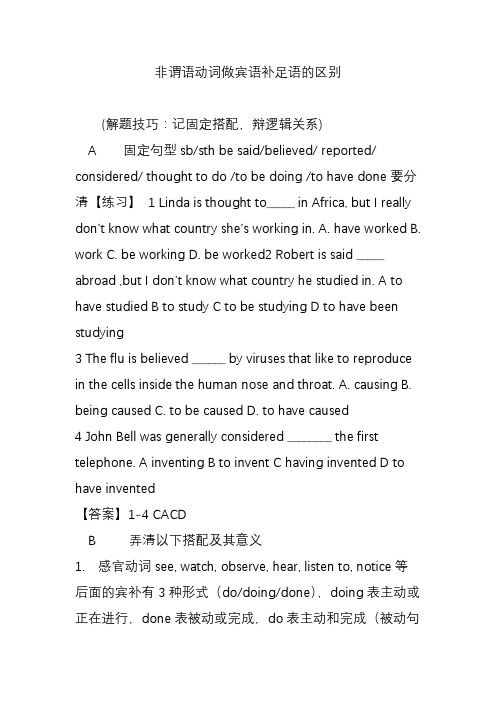
非谓语动词做宾语补足语的区别(解题技巧:记固定搭配,辩逻辑关系)A 固定句型sb/sth be said/believed/ reported/ considered/ thought to do /to be doing /to have done要分清【练习】1 Linda is thought to_____ in Africa, but I really don’t know what country she’s working in. A. have worked B. work C. be working D. be worked2 Robert is said _____ abroad ,but I don’t know what country he studied in. A to have studiedB to studyC to be studyingD to have been studying3 The flu is believed ______ by viruses that like to reproduce in the cells inside the human nose and throat. A. causing B. being caused C. to be caused D. to have caused4 John Bell was generally considered ________ the first telephone. A inventing B to invent C having invented D to have invented【答案】1-4 CACDB 弄清以下搭配及其意义1. 感官动词see, watch, observe, hear, listen to, notice等后面的宾补有3种形式(do/doing/done),doing表主动或正在进行,done表被动或完成,do表主动和完成(被动句中to 还原)。
非谓语动词作宾语补足语

非谓语动词作宾语补足语1. 在感官动词(feel, listen to, hear, see, look at, watch, notice 等)和使役动词(make, let, have)后,要用不带to 的不定式作宾补。
但在这些动词的被动式(如果可以变为被动式的话)后用作主语补足语的不定式要带to。
He made me work 12 hours a day. 他要我每天工作12小时。
I was made to work 12 hours a day. 每天要我工作12小时。
记忆方法:一感(feel)、二听(hear, listen to)、三让(let, have, make)、四看(see, look at, watch, notice)。
2. 在下列动词后用作宾语补足语的非谓语动词用不定式,即用于vt. + sb / sth + to do sth 的形式:advise 建议allow 允许ask 叫,请bear 忍受beg 乞求cause 导致command 命令encourage 鼓励expect 期待forbid 禁止force 迫使get 使hate 讨厌help 帮助intend 想要invite 邀请leave 让like 喜欢mean 打算need 需要oblige 迫使order 命令permit 允许persuade 说服prefer 宁愿request 请求remind 提醒teach 教tell 告诉trouble 麻烦want 想要warn 警告wish 希望wait for 等would like 想要would love 想要would prefer 宁愿注:(1) 在help 后作宾补的不定式带不带to 均可。
(2) 但fear, excuse, refuse, insist, hope, suggest, agree, decide, demand, thank, arrange 等动词后不可接sb to do sth。
(完整版)2.非谓语动词作宾补(解析版)
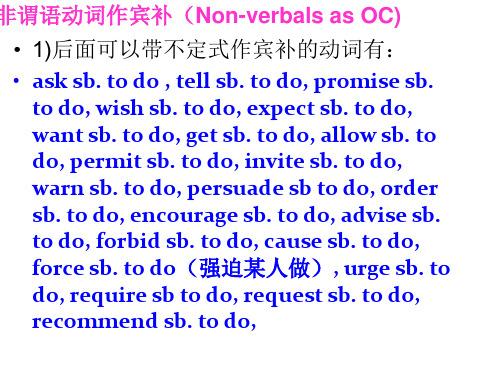
非谓语动词作宾补(Non-verbals as OC)
• 10.With everything well ____(arrange), he left the office.
• 11.With time _______(permit) , we plan to hold a class meeting.、
非谓语动词作宾补(Non-verbals as OC)
• 1.I had my wallet _____ (steal) on a bus last month.
• 2.The villagers got many trees ____(plant) just then.
• 3.She found the door ____(break) into when she came back.
非谓语动词作宾补(Non-verbals as OC)
• 7.I heard the song ____(sing) in English. • 8.He felt himself ____(cheat). • 9.With many brightly-colored flowers
____(come) out around the building ,his house looks like a beautiful garden.
非谓语动词作宾补(Non-verbals as OC)
• 19.The last time we saw the boy _______(swim) in the river was last week.(hear, notice, observe, watch)
• 20. The villagers got their kids ___ (help) them in the fields.
非谓语动词作宾语的情况
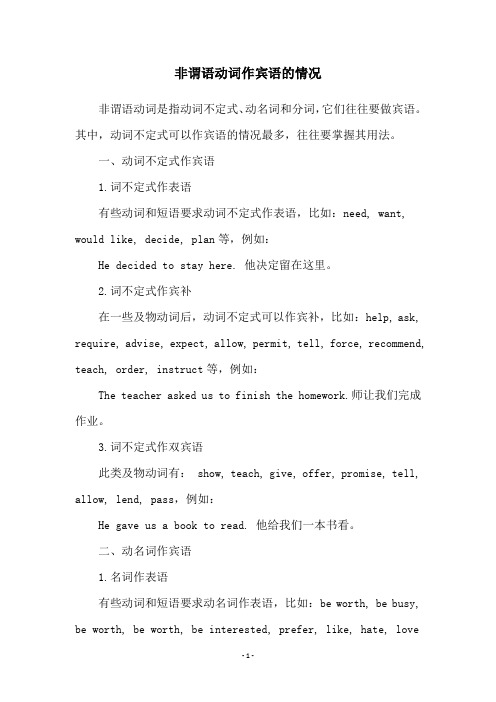
非谓语动词作宾语的情况非谓语动词是指动词不定式、动名词和分词,它们往往要做宾语。
其中,动词不定式可以作宾语的情况最多,往往要掌握其用法。
一、动词不定式作宾语1.词不定式作表语有些动词和短语要求动词不定式作表语,比如:need, want, would like, decide, plan等,例如:He decided to stay here. 他决定留在这里。
2.词不定式作宾补在一些及物动词后,动词不定式可以作宾补,比如:help, ask, require, advise, expect, allow, permit, tell, force, recommend, teach, order, instruct等,例如:The teacher asked us to finish the homework.师让我们完成作业。
3.词不定式作双宾语此类及物动词有: show, teach, give, offer, promise, tell, allow, lend, pass,例如:He gave us a book to read. 他给我们一本书看。
二、动名词作宾语1.名词作表语有些动词和短语要求动名词作表语,比如:be worth, be busy, be worth, be worth, be interested, prefer, like, hate, love等,例如:He was interested in reading books. 他喜欢看书。
2.名词作宾补动名词也可以作宾补,特别是在思考、看法、相信、知道、欢迎等动词后,有时也可以代替动词不定式,例如:We enjoy seeing them.们喜欢看到他们。
三、分词作宾语1.在分词作宾补有些及物动词后只能接现在分词作宾补,比如:catch(抓住), find(发现), listen(听见),look(看见)等,例如:She found him sleeping.发现他在睡觉。
非谓语动词作宾补

√ X
作宾补比较:常用句型三
catch
sb.doing sth. 高考题:He looked around and caught a putting man________(put)his hand into the pocket of a passenger. ask/invite/warn/cause/advise/petmit /encourage/persuade/tell/want/desire/prefer/ expect/request/order/allow/force/teach/beg /get/oblige/ sb.to do sth.其中 allow/permit/advise/forbid不涉及到某人后加 ing form.
练习
1.My
Hale Waihona Puke advisor encouraged me___________(take)a summer course to to take improve my writing skills. 2.Mrs Smith warned her daughter never__________ to drive (drive)after drinking. 3.The managers disscused the plan that they would like to see _____________(carry) carried out the next year. 4.A cook will be immediately fired if he is smoking found_________(smoke)in the kitchen. 5.I won’t have you__________(make)the making same mistake again.
非谓语动词(表格)

非谓语动词的分类、意义和构成非谓语形式构成特征和作用时态和语态否定式复合结构不定式分词现在分词过去分词动名词作宾语的非谓语动词比较情况常用动词只接不定式作宾语的动词只接动名词作宾语的动词及短语两者都可以意义基本相同意义相反两者都可以意义不同作宾语补足语的非谓语比较情况区别例句常接不定式作宾补的动词感官动词接非谓语形式作宾补使役动词接非谓语形式作宾补With复合结构作主语的非谓语比较情况区别例句意义不同it作形式主语的情况不同主谓一致不同作表语的非谓语比较情况区别例句意义不同My job today is _____________(water) all theflowers in the garden.My job is ____________(teach) English.Chinese is __________(interest), so Lucy isinterested in Chinese.He is ____________(fright).His speech is very encouraging.Her praise is encouraging us to work harder.The novel is well written.The novel was written by Lu Xun.作状语的非谓语比较情况区别例句不定式He stopped to have a rest.He got up early in order to/__________ catch the first train.He broke into the room,only to find an empty box. I’m pleased to meet you.It is such a good book for me as to read it three times.分词现在分词__________(walk) in the street, I came across an oldfriend of mine.(finish)his homework, the boy wentout._________(take) round the city, we were impressed bythe city’s new look._________(give) another chance, I can do it better.Tired out, they stopped to have a rest._________(laugh) and ________(talk), they went intothe classroom.The teacher came into the lab, __________(follow) bysome students.The song is sung all over the country, making it themost popular song.Judging form her accent, she must be from India.____________________(tell) many times, he stillrepeated the same mistake.过去分词独立主格结构The text finished, we began our holiday.Weather permitting, we are going to visit you tomorrow.He came out of the library, a large book under his arm. The meeting being over, we all left the room.作定语的非谓语比较情况用法例句不定式I haven’t a pen to write with.He had no money and no place to live (in).The present to be bought is for his mother.She was the first woman to win the gold medal in the Olympic Games.She is the only person to know the truth.He has no right to do it.Could you at least make an attempt to smile, Jim?I have no chance to go sightseeing.分词现在分词I don’t know the doctor __________(sit) on thechair.The building____________(build) now will be ahospital.The books________(write) by him is very popular.The professor ____________(come) hereyesterday will give us a lecture.The temple ______________________(destroy)by the earthquake will be rebuilt soon.The is the question _________(give).区别:falling leaves boiling waterfallen leaves boiled waterdeveloping countriesdeveloped countries过去分词动名词a sleeping baga walking sticka washing machine。
非谓语动词作宾补,定语,状语的区别以及练习题(含答案)

不定式、现在分词和过去分词作定语的区别(1)不定式作定语1)不定式与其所修饰的名词可能是主谓关系He was the last one to leave school yesterday.昨天他是最后一个离开教室的。
The train to arrive was from London.将要到站的火车是从伦敦开来的。
2)不定式与其所修饰的名词可能是动宾关系Get him something to eat.给他拿点儿东西吃。
She has a lot of work to do in the morning.早上他有很多工作要做。
3)不及物动词构成的不定式做定语,要加上适当的介词和被修饰的名词形成逻辑上的动宾关系,这里的介词不能省去。
I need a pen to write with.我需要一支笔写字。
There is nothing to worry about.没有什么值得发愁的。
4)不定式修饰一些表示方向、原因、时间、机会、权利等抽象名词如:ability能力,本领drive赶,驾驶movement运动,活动ambition抱负,野心effort努力,尝试need需要,需求campaign战役,运动failure失败,不及格opportunity机会chance机会force力,压力,要点promise许诺,希望courage勇气intention意向,意图reason理由,原因decision决定method方法,方式light光,光线,亮光determination决心,决定motive动机,目的struggle奋斗,努力,tendency倾向,趋势wish希望,愿望,祝愿5)被修饰的名词前有序数词、形容词最高级或next,second, last, only和not a,the等限定词时候,只能用不定式。
6)不定代词something, nothing, little, much, a lot 等习惯上用不定式做定语。
2非谓语动词做宾补的归纳
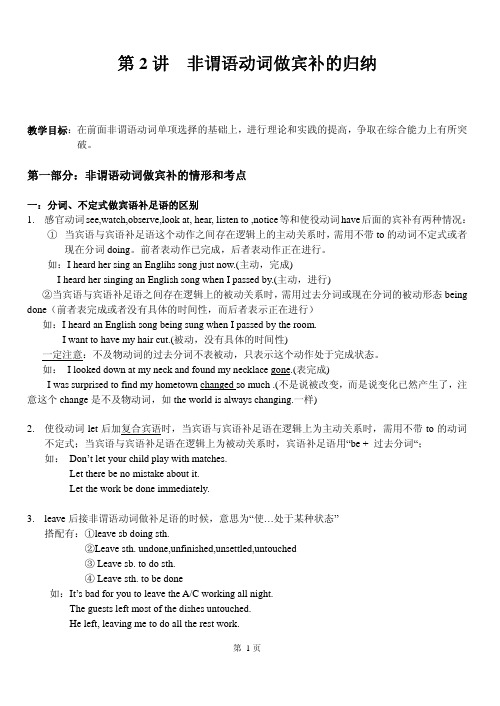
第2讲非谓语动词做宾补的归纳教学目标:在前面非谓语动词单项选择的基础上,进行理论和实践的提高,争取在综合能力上有所突破。
第一部分:非谓语动词做宾补的情形和考点一:分词、不定式做宾语补足语的区别1.感官动词see,watch,observe,look at, hear, listen to ,notice等和使役动词have后面的宾补有两种情况:①当宾语与宾语补足语这个动作之间存在逻辑上的主动关系时,需用不带to的动词不定式或者现在分词doing。
前者表动作已完成,后者表动作正在进行。
如:I heard her sing an Englihs song just now.(主动,完成)I heard her singing an English song when I passed by.(主动,进行)②当宾语与宾语补足语之间存在逻辑上的被动关系时,需用过去分词或现在分词的被动形态being done(前者表完成或者没有具体的时间性,而后者表示正在进行)如:I heard an English song being sung when I passed by the room.I want to have my hair cut.(被动,没有具体的时间性)一定注意:不及物动词的过去分词不表被动,只表示这个动作处于完成状态。
如:I looked down at my neck and found my necklace gone.(表完成)I was surprised to find my hometown changed so much .(不是说被改变,而是说变化已然产生了,注意这个change是不及物动词,如the world is always changing.一样)2.使役动词let后加复合宾语时,当宾语与宾语补足语在逻辑上为主动关系时,需用不带to的动词不定式;当宾语与宾语补足语在逻辑上为被动关系时,宾语补足语用“be + 过去分词“;如:Don’t let your child play with matches.Let there be no mistake about it.Let the work be done immediately.3.leave后接非谓语动词做补足语的时候,意思为“使…处于某种状态”搭配有:①leave sb doing sth.②Leave sth. undone,unfinished,unsettled,untouched③ Leave sb. to do sth.④ Leave sth. to be done如:It’s bad for you to leave the A/C working all night.The guests left most of the dishes untouched.He left, leaving me to do all the rest work.We hurriedly ended our meeting, leaving many problems to be settled.4.have, get后面接非谓语动词做宾语补足语时,意思为“使,让,叫”搭配有:①have/get sth. done (让某事由别人去做,让别人帮做某事)如:I’ll have/get my bike repaired tomorrow.②Have sth.done “使遭受…”如:Jack had his leg broken in a match.③Have sb/sth. doing 让…持续地做某事④Get sb./sth. doing 使…开始行动起来如:After a rest, the officer got the soldiers moving to the front.一定注意:have sb. doing 若是用在否定句中,have意思是“容忍”如:I won’t have you speaking to your dad like that.⑤have sb. do sth.Get sb. to do sth. 叫某人去做某事如:My mother had me go to the shop and buy some salt.二:下列动词后跟带to的不定式做补语Advise sb. to do, allow sb. to do, ask sb. to do,beg sb. to do,cause sb. to do,encourage sb. to do,expect sb. to do,forbid sb. to do, force sb. to do,get sb. to do, intend sb. to do, invite sb. to do,like sb. to do,love sb. to do,order sb. to do, persuade sb. to do, prefer sb. to do, require sb. to do, teach sb. to do, tell sb. to do, want sb. to do, warn sb. to do, wish sb. to do, think sb. to do, wait for sb. to do, call on sb. to do, depend on sb. to do,等等。
《非谓语作宾补》课件

2
To-Infinitive
Explore how the to-infinitive form is used as verb complements in various contexts.
3
Split Infinitive
Learn about the unique nature and usage of split infinitives as verb complements.
动名词作宾补的基本用法和例句
No Subject
Discover how gerunds are used as verb complements without a subject in sentences.
With a Subject
Explore how gerunds function as verb complements with an explicit subject in sentences.
区分非谓语作宾补和表语的语法现象
1 Sentence Structure
Learn about the grammatical clues to differentiate between verb complements and subject complements.
2 Meaning and Position
Explore practical techniques for transforming sentence patterns using verb complements.
Enhancing Expressions
Discover how verb complements can enrich your writing and storytelling skills.
非谓语动词作宾语补足语的用法剖析
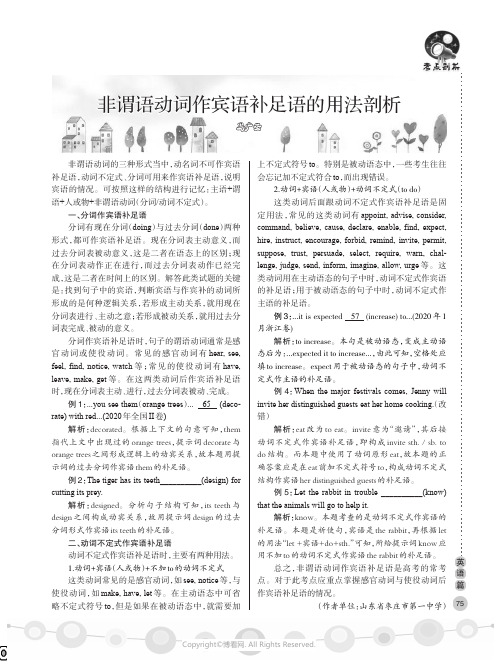
考点剖析非谓语动词的三种形式当中,动名词不可作宾语补足语,动词不定式、分词可用来作宾语补足语,说明宾语的情况。
可按照这样的结构进行记忆:主语+谓语+人或物+非谓语动词(分词/动词不定式)。
一、分词作宾语补足语分词有现在分词(doing)与过去分词(done)两种形式,都可作宾语补足语。
现在分词表主动意义,而过去分词表被动意义,这是二者在语态上的区别;现在分词表动作正在进行,而过去分词表动作已经完成,这是二者在时间上的区别。
解答此类试题的关键是:找到句子中的宾语,判断宾语与作宾补的动词所形成的是何种逻辑关系,若形成主动关系,就用现在分词表进行、主动之意;若形成被动关系,就用过去分词表完成、被动的意义。
分词作宾语补足语时,句子的谓语动词通常是感官动词或使役动词。
常见的感官动词有hear,see,feel,find,notice,watch等;常见的使役动词有have,leave,make,get等。
在这两类动词后作宾语补足语时,现在分词表主动、进行,过去分词表被动、完成。
例1:...you see them(orange trees)...65(deco-rate)with red...(2020年全国II卷)解析:decorated。
根据上下文的句意可知,them指代上文中出现过的orange trees,提示词decorate与orange trees之间形成逻辑上的动宾关系,故本题用提示词的过去分词作宾语them的补足语。
例2:The tiger has its teeth__________(design)forcutting its prey.解析:designed。
分析句子结构可知,its teeth与design之间构成动宾关系,故用提示词design的过去分词形式作宾语its teeth的补足语。
二、动词不定式作宾语补足语动词不定式作宾语补足语时,主要有两种用法。
1.动词+宾语(人或物)+不加to的动词不定式这类动词常见的是感官动词,如see,notice等,与使役动词,如make,have,let等。
- 1、下载文档前请自行甄别文档内容的完整性,平台不提供额外的编辑、内容补充、找答案等附加服务。
- 2、"仅部分预览"的文档,不可在线预览部分如存在完整性等问题,可反馈申请退款(可完整预览的文档不适用该条件!)。
- 3、如文档侵犯您的权益,请联系客服反馈,我们会尽快为您处理(人工客服工作时间:9:00-18:30)。
非谓语动词作宾补的比较
一、现在分词作宾补
现在分词作宾补表示动作当时正在进行,尚未结束,强调动作的发生过程或当时一段时间的状态。
此时,宾语与宾补之间的关系是主动的主谓关系。
下列两类动词之后通常用现在分词作宾补。
1、表“感觉”的动词:see; watch; observe; notice; look at; feel; find; catch; hear; listen to等。
例如:
I heard Tom singing an English song in the next room.(汤姆正在发出“唱歌”这个动作。
)
On the top of the hill, he could see smoke rising from the chimneys. (炊烟正在发出“升起”这个动作。
)
He looked around and caught a man putting his hand into the pocket of a passenger.
他环顾四周,无意中发现一个人正在偷旅客的钱包。
(catch sb doing sth.“无意发现某人(正)在做什么”。
) He was found smoking in the hall, so he was fined heavily. 有人发现他在大厅里抽烟,结果被重罚。
2、表“使役”的动词:have; keep; get; start; send; leave; set等。
例如:
His letter left me feeling pretty bad.他的信使我感到相当难受。
(指当时那段时间的状态。
)
What she said set me thinking.她说的话让我深思。
(指当时那段时间“思考”的状态。
)
I’m sorry to keep you waiting so long a time. 很抱歉让您久等了。
(指当时那段时间“等待”的状态。
)
二、过去分词作宾补
过去分词作宾补,强调动作的完成和结果,此时,宾语与宾补之间的关系是被动的主谓关系。
它主要是用在下列三类动词之后。
1、表示“感觉”的动词,主要有see; watch; observe; notice; look at; feel; find; catch; hear; listen to等。
例如:When they got there,they found the house burnt down.(房子已经被“烧掉”,强调结果。
)
I heard the song sung yesterday.(歌被人“唱”。
)
2、表示“心理状态”的动词:like; think; expect; want; wish等。
例如:
The waitress asked the American how he liked his steak cooked.
女服务员问那个美国人愿意怎么烹调牛排。
(牛排被“烹调”。
)
I wish my homework finished be fore five o’clock.. (作业被“完成”。
)
3、表示“使役”的动词:have; get; leave; keep; make; order 等。
Don’t leave those things undone..要把那些事情做完。
(事情被“做”。
)
The teacher couldn’t make himself paid attention to because there was too much noise outside.
老师无法让(学生)集中注意力,因为外面太吵了。
(指老师本人不能被学生“注意”。
)
注意:
使役动词have接过去分词作宾补有两种意义,具体指那种意义,要根据上下语境来确定。
过去分词所表示的动作由主语让他人完成的。
例如:
1) I’ll have my hair cut tomorrow. (虽然头发被理,但这里指主语“我”让理发师理发。
)
2) 过去分词所表示的动作是指主语所经历的一件不好的事情。
例如:
He had his leg broken when he was playing football yesterday.
他昨天打足球的时候,腿被摔断了。
(虽然腿被摔断,但这里指主语的不好的一次经历,与第一点意思不一样。
)三、动词不定式作宾补
在英语中有些动词要求接动词不定式作宾补。
它表示该动作发生在谓语动词之后,属将要发生的动作。
应注意如下几个方面:
1、带to的不定式作宾补。
有这种用法的动词常见的有:ask; tell; get; wish; like; want; expect; prefer; enable; teach;
know; understand; would like; cause; force; know; intend; permit; request; order; invite; encourage; warn; remind;
oblige; forbid; challenge; drive等。
例如:
Wei Fang asked me to go shopping with her.(“逛商场”这个动作发生在“叫”之后。
)
Our teacher encouraged us to study harder.(“努力学习”发生在“鼓励:之后。
)
注意:
1)当表示“见解、看法”的动词后带不定式作宾补时,其宾补形式通常是to be或to have done。
这类词通常有:believe; consider; declare; discover; guess; declare; find; imagine; judge; feel (认为); suppose; think; understand等。
例如:
I consider him to have done wrong.我认为他做错了。
Later, he discovered the story to be true.后来,他发现那个故事是真实。
2)表示“好恶”的动词后带不定式作宾补时,不能用于被动。
这类动词主要动词有:like; dislike; prefer; hate; love; want等。
例如:
I hate people to tell lies. 我厌恶人说谎。
Do you prefer me to do the work by myself?你更愿意我独自做这个工作。
3)某些短语动词后可带不定式作宾补。
这类动词主要有arrange for; ask for; call on; count on; depend on; long for; rely on; wait for等。
例如:
You can not count on Tom to help you. 别指望汤姆能够帮你。
I am waiting for you to reply. 我在等你的答复。
2、省to的不定式作宾补。
这类动词有feel; hear; listen to; have; let; make; see; look at; notice; observe; watch。
这类
动词后的宾补表示该动作已经结束或未来要发生的动作。
应注意:在主动语态中省to,在被动语态中要to, 其中have没有被动式。
例如:
We saw them play football yesterday. (表示看了“打足球”整个过程。
在主动语态中省to。
)
He was made to stand outside for two hours. (在被动语态中要加to。
)。
